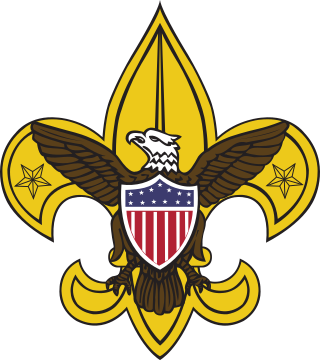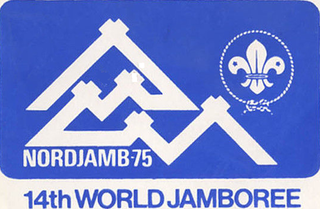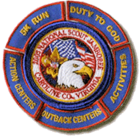
A Scout is a child, usually 10–18 years of age, participating in the worldwide Scouting movement. Because of the large age and development span, many Scouting associations have split this age group into a junior and a senior section. Scouts are organized into troops averaging 20–30 Scouts under the guidance of one or more Scout Leaders or Scoutmasters. Troops subdivide into patrols of about 6–8 Scouts and engage in outdoor and special interest activities. Troops may affiliate with local, national, and international organizations. Some national Scouting associations have special interest programs such as Air Scouts, Sea Scouts, outdoor high adventure, Scouting bands, and rider Scouts. In the United States there were around 6 million scouts in 2011.
Scouting in Florida is composed of Boy Scouts of America (BSA) and Girl Scouts USA (GSUSA) local councils in Florida. Scouting in Florida has a long history, from the 1910s to the present day, serving thousands of youth in programs that suit the environment in which they live.

A camporee is a local or regional gathering of Scouting units for a period of camping and common activities. Similar to a camporee, a jamboree occurs less often and draws units from the entire nation or world. It should not be confused with the Australian term "jamborette".

The National Scout jamboree is a gathering, or jamboree, of thousands of members of the Boy Scouts of America, usually held every four years and organized by the National Council of the Boy Scouts of America. Referred to as "the Jamboree", "Jambo", or NSJ, Scouts from all over the nation and world have the opportunity to attend. There is also an event called World Scout Jamboree which is the same concept but instead of national it is international" They are considered to be one of several unique experiences that the Boy Scouts of America offers. The first jamboree was scheduled to be held in 1935 in Washington, D.C. to celebrate the 25th anniversary of Scouting, but was delayed two years after being cancelled due to a polio outbreak. The 1937 jamboree in Washington attracted 25,000 Scouts, who camped around the Washington Monument and Tidal Basin. The event was covered extensively by national media and attended by President Franklin D. Roosevelt.

The Scout Association of Hong Kong is the largest scouting organisation in Hong Kong. Scout training was first introduced in Hong Kong by Rev Spink of St Andrew's Church, Kowloon in 1909 and 1910 by the Protestant based Boys' Brigade, Chums Scout Patrols and British Boy Scouts. The Catholic St. Joseph's College, formed its Boy Scout Troop in 1913, and registered with the Boy Scouts Association of the United Kingdom in 1914. The Boy Scouts Association formed its Hong Kong Local Association in July 1915 which became its Hong Kong Branch. After changes to the name of the United Kingdom organisation in 1967, the branch name was changed to The Scout Association Hong Kong Branch. In 1977, The Scout Association of Hong Kong was constituted as an autonomous association and successor to The Scout Association's Hong Kong Branch and became the 111th member of the World Organization of the Scout Movement (WOSM) in 1977.

Estonian Scout Association is the primary national Scouting organization of Estonia, became a member of the World Organization of the Scout Movement in 1996. The coeducational Eesti Skautide Ühing has 1,337 members as of 2011.

Yawgoog Scout Reservation is a 1,800-acre (7 km2) reservation for scouting located in Rockville, Rhode Island and operated by the Narragansett Council of the Boy Scouts of America. Founded in 1916, Yawgoog is the fifth oldest Boy Scout camp in the United States. At the camp is run an eight-week camping program every summer where Boy Scouts stay for a week with their troops. The reservation is divided into three camps: Three Point, Medicine Bow, and Sandy Beach.

William Hillcourt, known within the Scouting movement as "Green Bar Bill", was an influential leader in the Boy Scouts of America (BSA) organization from 1927 to 1992. Hillcourt was a prolific writer and teacher in the areas of woodcraft, troop and patrol structure, and training; his written works include three editions of the BSA's official Boy Scout Handbook, with over 12.6 million copies printed, other Scouting-related books and numerous magazine articles. Hillcourt developed and promoted the American adaptation of the Wood Badge adult Scout leader training program.
Venturer Scouts, formerly Senior Scouts, and commonly known simply as Venturers, is the fourth section of Scouts Australia, and was first formed in 1946. Venturers are aged between 14.5 and 18 years of age and are organised into Units, which can be a part of a single Scout Group or a stand-alone group. Both types of Unit take Scouts from any Scout Group. Although not in common usage, the motto of the Venturer Scout section in Australia is "Look Wide".
The Australian Scout Jamboree is a national jamboree overseen by Scouts Australia. They have been held regularly since 1934, except for 1942 and 1945 due to World War II, and in 2022 due to the COVID-19 pandemic. Jamborees are generally held early in January and typically runs for ten nights.

Scouts BSA is the flagship program and membership level of the Boy Scouts of America (BSA) for coeducational young people between the ages of typically 11 and 17. It provides youth training in character, citizenship, personal fitness, and leadership, and aims to develop the skills necessary to become successful adults.

Since Scouting began in 1907, it has entered into many elements of popular culture, including movies, TV and books.

The 21st World Scout Jamboree was held in July and August 2007 and formed a part of the Scouting 2007 Centenary celebrations of the world Scout Movement. The event was hosted by the United Kingdom, as 2007 marked the 100th anniversary of the founding of Scouting on Brownsea Island.

The 1993 National Scout Jamboree was the 13th national Scout jamboree of the Boy Scouts of America and was held from August 4-10, 1993, at Fort Walker, Virginia.

The Patriots' Path Council is a not-for-profit organization that establishes ideals in youth to help them make ethical choices by instilling values of good character, citizenship, personal fitness, and guidance. It serves members in the counties of Morris, Sussex, Somerset, Union, Hunterdon, and parts of Middlesex in New Jersey. It was established in 1999 with the merger of the Morris-Sussex Area Council (1936–1999) and the Watchung Area Council (1926–1999). On February 6, 2014, Patriots Path Council absorbed several Scouting units from the dissolved Central New Jersey Council (1999-2014).

The 14th World Scout Jamboree was held from 29 July to 7 August 1975, and was hosted by Norway at Lillehammer, on the shore of the Gudbrandsdalslågen river.

Jamboree 2008 was developed as "an Inter-organisational & International event" which was intended to "bring 600 young people from Scouting and Guiding together — to develop skills & friendships that will lay the foundations for the next 100 years of Scouting". The Jamboree was set up to be independent of Associations, and hoped to involve members of the World Federation of Independent Scouts (WFIS), the World Organization of the Scout Movement (WOSM), and the World Association of Girl Guides and Girl Scouts (WAGGGS).

The 2010 National Scout Jamboree was the 17th national Scout jamboree of the Boy Scouts of America and was held from July 26 to August 4, 2010, at Fort A.P. Hill, Virginia. The 2010 National Scout Jamboree celebrated the 100th anniversary of the Boy Scouts of America and was the last jamboree held at Fort A.P. Hill. With more than 50,000 in attendance, the 2010 National Scout Jamboree was the largest overall since 1973, and the largest at a single location since 1964. All subsequent jamborees have been held permanently at The Summit Bechtel Family National Scout Reserve, the Boy Scouts of America's fourth High Adventure base. This was also the first jamboree to include Venturing programs.

Laurel Highlands Council serves youth in Allegheny, Beaver, Bedford, Blair, Cambria, Greene, Indiana, Somerset, and Washington counties in Pennsylvania; Grant, Hampshire, Hardy, and Mineral counties in West Virginia; and Allegany and Garrett counties of Maryland.
The New Zealand Scout Jamboree is a Jamboree which is held every three years by Scouts New Zealand. The Jamboree is traditionally held in summer between late December and early January, with a significant New Years party. The 23rd New Zealand Scout Jamboree was held at Mystery Creek Events Centre, Hamilton in the North Island from 30 December 2023 to 7 January 2024.




















